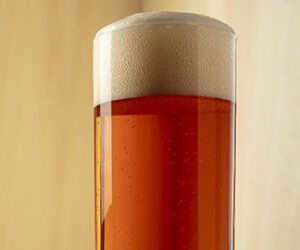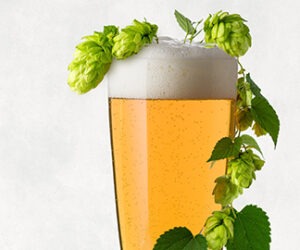Wee Heavy

Those that go toward the malty side eventually want to brew strong Scotch ale. It is kind of like the IPA of the malty world. Also known as wee heavy, it is a rich, malty beer. Do not confuse strong Scotch ale with the much lower alcohol Scottish strong ale. To avoid confusion, I think it is better to refer to strong Scotch ale as wee heavy. While wee heavy is related to the lower-alcohol Scottish ales, and could be considered a higher shilling version of them, wee heavy’s higher starting gravity results in a different beer.
A good wee heavy is sweet, but not cloying, has a complex malt character, and has a warming, yet not harsh, alcohol presence. Enhancing the perception of sweetness is a low level of hop bitterness and considerable melanoidin character either from long boil times or specialty malt additions. Fermenting higher gravity wort not only results in higher alcohol beer, but also some additional ester formation. A good example of this beer will not be as clean and low-ester as Scottish ale. The color should range from light copper to dark brown, often with deep ruby highlights.
Unfortunately, quite a large number of judges still seem to reward only sweet, full, and boozy examples of the style. If you want to win at competition, you need to focus on bigger beers for this category. They expect a beer with warming alcohol, sweet malt complexity, and caramel notes. As for appearance, lean toward darker beers, but avoid roasted character. Hop bitterness should just barely balance the malt sweetness and late hop character should be minimal or non-existent.
Much of the rich malty flavors in wee heavy come from selecting a proper base malt. To brew an award-winning example of this style, start with British pale ale malt as the base. It provides that background biscuit-like malt character that is a key component in fine British beers. British pale ale malt is kilned a bit darker (2.5 to 3.5 °L) than the average American 2-row or pale malt (1.5 to 2.5 °L) and this higher level of kilning brings out the malt’s biscuity flavors. Some brewers use North American pale ale malt or North American 2-row with the addition of 5–10% Munich malt when they cannot source British pale ale malt. This will not produce the same beer as using British pale ale malt, but will produce a pleasant malt background.
Extract brewers should make the effort to source an extract made from British pale ale malt. If you end up using North American 2-row malt extract, you will need to compensate by partial mashing some additional specialty malts such as Munich or biscuit. For a 5-gallon (19-liter) batch, use about 5–10% of the total base malt.
All-grain brewers should use an infusion mash. You will find a temperature in the range of 152–158 °F (67–70 °C) works well. Use a lower temperature when using lower attenuating yeasts or higher starting gravities. Use a higher mash temperature when using the higher attenuating yeasts or lower starting gravity beers. If you are unsure, a great starting point is 154 °F (68 °C).
In theory, you can brew a great example of the style by using only base malt, some roasted barley for color (less than 3%), and an extensive boil. The extensive boil is to develop malt flavors that are a key component to the style. Judges will expect some caramel flavors and aromas in wee heavy and you can develop them through extended boiling. The best way, if you want to try it, is to boil down one gallon (4 L) of first runnings until it is thick and syrupy. While you will develop some caramel flavors by boiling for an extended time, it can be hit or miss. Often there is not enough caramel flavor or the flavor that develops is more toffee-like and judges think the beer has a diacetyl problem.
So, the easiest and most consistent way to get the proper caramel character is the use of crystal malt. Allocating 5-10% of the grist for crystal malt should add the right character. I prefer to split the crystal malts into a couple different color ranges. Lighter color crystal malts add sweeter caramel notes, mid-color crystal adds more caramel flavor, and dark crystal adds some raisin notes. The beer should have a rich color, so a touch of highly kilned malts, such as roasted barley can add a hint of balancing dryness and the depth of color that judges are looking for.
If you are looking for more complexity, you can add other specialty malts. Wheat malt, Victory®, biscuit, and others are common additions in many recipes, but restraint is important so that the beer does not become saturated with non-fermentable dextrins and cloying flavors. In general, keep the total of all specialty grain additions to less than 20% of an all-grain grist. Keep highly kilned malt additions small (less than 3%), as bold roasted flavors are not appropriate.
If you want to develop more color and more melanoidin-based flavors and aromas, start with a larger pre-boil volume so you can boil the wort for two hours or more. This develops a unique character that is not possible by grain additions alone. Regardless of what you might read on the Internet, do not add peat smoked malt to your wee heavy. It is not appropriate. Any suggestion of smoke character is possibly from the use of roasted barley and long boil times. It is not from the water and it is not from peat smoke.
Wee heavy is best brewed with English hops such as East Kent Golding, Fuggle, Target, North-down, or Challenger. As a general rule of thumb, you can skip any late hop additions. If you do add late hops, make sure they do not overwhelm the malt character — a half-ounce (14 g) of a mild hop, such as Kent Golding, would be about all you should add.
Bittering additions are similarly subtle. You want just enough hop bitterness to add a little balance to the malt sweetness. Target a bitterness to starting gravity ratio (IBU divided by OG) of 0.2 to 0.4. One thing to be aware of is the effect of highly kilned specialty malts on the perception of dryness and bittering. If you use more low color malts, such as crystal for color, the beer will have a sweeter overall impression than if you use just base malt and roasted barley for color. You would adjust your bittering slightly to account for this difference.
Fermentation for all of the Scottish ale styles requires a clean, neutral yeast character. The goal for wee heavy is a beer with relatively low esters, as compared to British ales, and lots of rich malt flavor.
While I prefer White Labs WLP001 (California Ale) or Wyeast 1056 (American Ale) for the lower gravity Scottish ales, I like yeast with a little more fermentation character and a richer maltiness for wee heavy. White Labs WLP028 (Edinburgh Ale) and Wyeast 1728 (Scottish Ale) are both excellent choices for this style as well. In a pinch, you could use other yeasts. The important thing is finding one that has a more malt forward character.
Cool fermentation, proper pitching rates, adequate yeast nutrition, and the proper addition of oxygen to the wort also factor into getting that rich malt character, gentle warming alcohol, and fully attenuated (not syrupy) beer. On bigger beers like this, I start fermentation at the lower end of their range and then let the temperature rise at least a few degrees over the course of a couple of days. This helps moderate the production of hot tasting alcohols, helps the yeast attenuate fully, and keeps the amount of diacetyl in the finished beer to a minimum.
Recipe
McZainasheff’s Wee
(5 gallons/19 L, all-grain)
OG = 1.099 FG = 1.026 IBU = 28 SRM = 20 ABV = 9.7%
Ingredients
17.8 lbs. (8.1 kg) British pale ale malt
17.6 oz. (0.5 kg) crystal malt (45 °L)
14.1 oz. (0.4 kg) Munich malt (8 °L)
7 oz. (0.2 kg) crystal malt (120°L)
1.8 oz. (50 g) roasted barley (500 °L)
6.5 AAU Kent Golding hops (60 min.) (1.3 oz./37 g at 5% alpha acids)
2 AAU Kent Golding hops (10 min.) (0.4 oz./11 g at 5% alpha acids)
1 tsp Irish moss (optional)
White Labs WLP028 (Edinburgh Ale) or Wyeast 1728 (Scottish Ale) yeast
Step by Step
When I homebrew, I use Crisp Malting’s British Pale Ale malt (made from Maris Otter) as my base grain, but other malts of a similar nature should work well. Remember, the bulk of the flavor comes from the base grain, so try to get British pale ale malt.
Currently I use the Thomas Fawcett crystal and pale chocolate malts, as they have a great flavor that is very British. For Munich malt we’re currently using Best Malz. For any of these malts, feel free to substitute any high quality malt of a similar flavor and color from a different supplier. My hops are in pellet form and come from Hop Union, Willamette Valley, or Hopsteiner depending on the variety.
Mill the grains and dough-in targeting a mash of around 1.5 qts. (1.4 L) of water to 1 pound (0.45 kg) of grain (a liquor-to-grist ratio of about 3:1 by weight) and a temperature of 154 °F (68 °C). Hold the mash at 154 °F (68 °C) until enzymatic conversion is complete. Infuse the mash with near- boiling water while stirring or with a recirculating mash system raise the temperature to mash out at 168 °F (76 °C). Sparge slowly with 170 °F (77 °C) water, collecting wort until the pre-boil kettle volume is around 6.5 gallons (25 L) and the gravity is 1.076. If you should come up short on the pre-boil gravity, top it off with some dried malt extract (DME).
The total wort boil time is 90 minutes. This helps concentrate the wort and aids in the development of flavor compounds. You should check the gravity of your wort before you add your first hop addition. If the boil is not tracking according to plan, keep boiling until you are at the right gravity, and then add your first hop addition. The first hop addition comes with 60 minutes remaining in the boil. If you wish, add Irish moss or other kettle finings with 15 minutes left in the boil and the final hop addition with 10 minutes left.
Chill the wort to 65 °F (18 °C) and aerate thoroughly. The proper pitch rate is 3 packages of liquid yeast, or 1 package of liquid yeast in a 1.5-gallon (6 L) starter. Ferment at 65 °F (18 °C) to start, raising the temperature gradually to 70 °F (21 °C) for the last 1⁄3 of fermentation. When finished, carbonate the beer to approximately 2 volumes CO2. Use the BYO priming chart if bottling at https://byo.com/resources/carbonation
McZainasheff’s Wee
(5 gallons/19 L, extract with grains)
OG = 1.099 FG = 1.026 IBU = 28 SRM = 20 ABV = 9.7%
Ingredients
11.8 lbs. (5.4 kg) British pale liquid malt extract (LME)
17.6 oz. (0.5 kg) crystal malt (45 °L)
14.1 oz. (0.4 kg) Munich malt (8 °L)
7 oz. (0.2 kg) crystal malt (120°L)
1.8 oz. (50 g) roasted barley (500 °L)
6.5 AAU Kent Golding hops (60 min.) (1.3 oz./37 g at 5% alpha acids)
2 AAU Kent Golding hops (10 min.) (0.4 oz./11 g at 5% alpha acids)
1 tsp Irish moss (optional)
White Labs WLP028 (Edinburgh Ale) or Wyeast 1728 (Scottish Ale) yeast
Step by Step
Ask your local homebrew shop for an English-style liquid malt extract. If they do not have any, many online suppliers sell an English-style extract made from 100% Maris Otter malt. Always choose the freshest extract that fits the beer style. If you cannot get fresh liquid malt extract, it is better to use an appropriate amount of dried malt extract (DME) instead.
Currently I use the Thomas Fawcett crystal and pale chocolate malts, as they have a great flavor that is very British. For Munich malt we’re currently using Best Malz. For any of these malts, feel free to substitute any high quality malt of a similar flavor and color from a different supplier. My hops are in pellet form and come from Hop Union, Willamette Valley, or Hopsteiner depending on the variety.
Mill or coarsely crack the specialty malt and place loosely in a grain bag. Avoid packing the grains too tightly in the bag, using more bags if needed. Steep the bag in about 1 gallon (~4 L) of water at roughly 170 °F (77 °C) for about 30 minutes. Lift the grain bag out of the steeping liquid and rinse with warm water. Allow the bags to drip into the kettle for a few minutes while you add the malt extract. Do not squeeze the bags. Add enough water to the steeping liquor and malt extract to make a pre-boil volume of 6.5 gallons (25 L) and a gravity of 1.076. Stir thoroughly to help dissolve the extract and bring to a boil.
The total wort boil time is 90 minutes. This helps concentrate the wort and aids in the development of flavor compounds. You should check the gravity of your wort before you add your first hop addition. If the boil is not tracking according to plan, keep boiling until you are at the right gravity, and then add your first hop addition. The first hop addition comes with 60 minutes remaining in the boil. If you wish, add the Irish moss or other kettle finings with 15 minutes left in the boil. Then add the final hop addition with 10 minutes left. Chill the wort to 65 °F (18 °C) and aerate thoroughly. The proper pitch rate is 3 packages of liquid yeast, or 1 package of liquid yeast in a 1.5-gallon (6 L) starter. Ferment at 65 °F (18 °C) to start, raising the temperature gradually to 70 °F (21 °C) for the last 1⁄3 of fermentation. When finished, carbonate the beer to approximately 2 volumes CO2.



